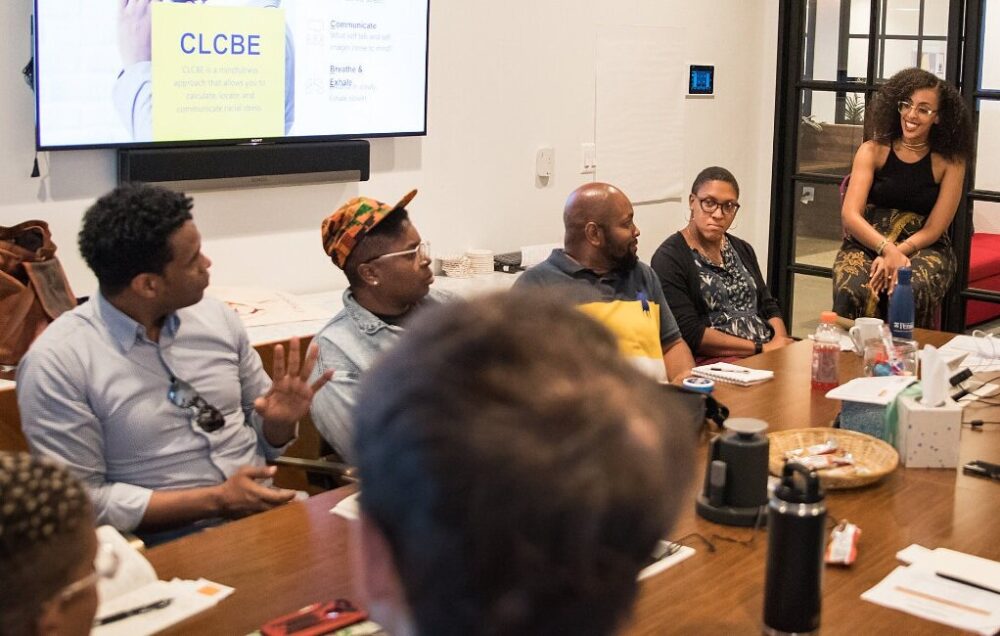As Black History Month 2021 draws to a close, CIC sat down with Lion’s Story, a member of CIC Philadelphia’s Social Impact Cohort, to explore the opportunities and challenges of building racial literacy in the workplace.
Lion’s Story helps organizations to increase their racial literacy — that is, the ability to recognize and resolve racially stressful social interactions — through training methods based in storytelling and mindfulness.
Recognizing that conversations on race can be difficult, particularly in professional settings, Lion’s Story aims to equip individuals with the skills to understand their own racial narratives and engage in honest, productive dialogue. At the core of their approach is the CLCBE racial stress reduction mindfulness strategy, which starts with observation of one’s feelings and finally ends with breathwork that calms the nervous system.
In the conversation below, we discuss shame, the brain’s response to narratives, and the critical need for organizational racial literacy in the context of the murders of George Floyd and Breonna Taylor, the reawakening of the Black Lives Matter movement, and racial disparities in the pandemic’s impact in the United States.
Led by Rachel Ezekiel-Fishbein of Making Headlines PR, our conversation features:
-
Charles Barrett Adams, Managing Partner/Co-Founder at Lion’s Story
-
Shamm Hadgu Petros, Partner/Director of Learning & Evaluation at Lion’s Story
-
Howard Stevenson, PhD, Co-Founder at Lion’s Story and Constance E. Clayton Professor of Urban Education and Africana Studies at the University of Pennsylvania
-
Minna Hyon, Events Lead at CIC Philadelphia
This conversation was edited for space and clarity.
CIC: Let’s start by hearing about your mission at Lion’s Story.
Shamm Hadgu Petros: Our mission is to develop the skills and capacity in individuals and institutions to process racial stress, claim stories, and heal from racial conflict. We envision a racially literate world where people have a full understanding and authorship of their own racial stories for the direct benefit of themselves, their communities, and organizations.
CIC: That’s ambitious. What barriers do you face in this type of work?
Howard Stevenson: Part of the issue for people is knowing how to live in a world where they’re not “superior.” What else do you have to do if you’re not superior in navigating the world? How do you make choices? How do you listen to people who are different than you if you are equal and don’t have the benefits of power?
Some people are afraid to “do race” because they don’t want to give up power and privilege. We’re all traumatized but in very different ways.
Charles Barrett Adams: Black, brown, Indigenous folks — we know we’re traumatized. We experience it and live it and we know it. I think other folks don’t realize it. Oftentimes, when we work with organizations, people refuse to engage, even though this is where they are employed. There’s fear, but they also question why.
Our work is skills based; we believe in competency over character. There are ways that you can heal, process, and engage with these racially stressful, face-to-face, interactive moments.
data-animation-override>
“The Lion’s Story will never be known as long as the hunter is the one to tell it.”
CIC: How does it work when the people who most need to do the work refuse to do so?
CBA: We do our best to create a space that can allow them to at least take a risk. Mostly we’re successful, but honestly, you can’t make people do something.
SHP: We tell our client partners that when you do this work, you’re going to start recognizing things in your community and you’re going to be able to read your environment better than you have in the past, and one of those things is that some people don’t belong or some people are not ready for the level of work you’re trying to engage them in. And that is their true reality: folks who are extremely avoidant of racial topics who are expected to step into a Lion’s Story training will experience racial stress. They will be heightened to all these different psycho-emotional-sensory experiences, because this might be the first time they’ve had to talk about and sit with race. And I think that’s a success.




